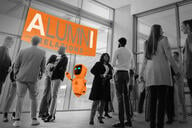You have /5 articles left.
Sign up for a free account or log in.
What access rights do the news media have on campuses?
The clash between news reporters, protesters and faculty at the University of Missouri has sparked a dialogue about First Amendment rights, media coverage of protest and why protesters might not want the news media in their midst.
Not surprisingly, the news media are reporting the incident as a violation of freedom of the press, and they may be right. But there are boundaries when it comes to media access on campus, and it's worth discussing them.
Years ago when I was an administrator at the University of Michigan, we had a horrific incident in which a student living in graduate student housing was stabbed to death by her live-in boyfriend. The assailant followed her out of the apartment and finished his attack outside in the yard in full view of the residents, many of whom had families with children. The sensational nature of the crime led to an embankment of satellite trucks, cameras and reporters in the grassy area outside the apartments, many of whom shone lights on and took up camera angles that looked right into the apartment windows of nearby residents.
We did not feel we could remove them because this was a major news story and because Michigan is a public university. But after the disaster was over, we began to question our decision making. Was it really reasonable to allow families to have their homes intruded on in this way? Could we not set reasonable and respectful boundaries?
I remember another circumstance when, after the Sept. 11 attacks, students were holding a candlelight vigil to grieve and express their sorrow. That created powerful visuals for the media, who again showed up in droves. The cameras sometimes positioned themselves inches from a crying student's face. Purely on compassionate grounds, that would seem to be an unreasonable invasion of privacy. But where to draw the line? Would it be OK for cameras to record the vigil but from a reasonable distance? How much personal space is sufficient?
Yet another ambiguous circumstance occurs when student reporters have access to potential sources in situations that are normally shielded from the media. Is it OK for student reporters to interview students in their dorm who are grieving over a fellow student who has died? Can they take pictures for publication in spaces that are normally off-limits to the public?
For public institutions funded by taxpayers, the presumption should be for access. But, even there, limits can be set. Conversely, private institutions have more latitude to restrict media access, but it is not always in their best interest to exercise that right. Many private colleges have a "public square" space where events and protests more frequently occur, and they often grant journalists broader access to those spaces than to private campus buildings.
In the aftermath of the stabbing death at Michigan, a group of us who worked at the university got together to create some clear policies around media access. We consulted many experts, including lawyers and those who advise the student media. In the end, we formalized and disseminated a set of guidelines that could help everyone make better decisions, rather than acting in the heat of the moment.
We shared the guidelines with media outlets regularly covered the university, including the student newspaper. We educated student groups that might be in the news about both access and boundaries. And when we knew big events were coming up that would attract media (such as the Sept. 11 vigil), we reached out in advance to remind reporters of our policies. All of this proactive work led both to more access when it was warranted and to better adherence by the media to reasonable boundaries.
Michigan's guidelines have been updated periodically over the years, but the core ideas have remained consistent. The presumption is for access, and the university typically allows all media such access in outdoor campus spaces and inside events that are open to the public.
However, some clear exceptions are spelled out. Among other situations, media access may be limited in:
- Clinical or waiting areas where counseling or medical care is being provided, in order to protect patient privacy
- Student housing areas including courtyards, lounges and other places where people may have a reasonable expectation of privacy
- Classrooms when class is in session
- Libraries, museums and other areas where quiet study is enforced or collections may be damaged by media equipment
- Research labs
- Private functions that are by invitation only
- Active crime scenes or areas deemed to be unsafe (such as after a fire or earthquake).
If your campus has not created such guidelines, I encourage you to do so and to consult widely, using this as an opportunity to have a thoughtful conversation about your college or university’s particular culture, values and reasonable boundaries. It is more helpful to have the discussion before you are in the midst of an incident where emotions are running high and people may act without thinking.
In addition, I recommend that campuses provide guidance to student groups and their advisers about interacting with the media. You can use development of media access policies as a hook for a discussion with students.
You can also watch for student groups that emerge in the news and get to them early in the cycle with expert counsel and an offer of support. During my time at Michigan, we frequently did this through a close partnership between the communications office and student affairs.
All of this proactive work will help you get through the moments when your campus is suddenly thrust into the spotlight. By the time the satellite trucks show up, it may be too late.




